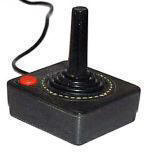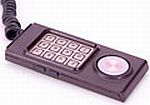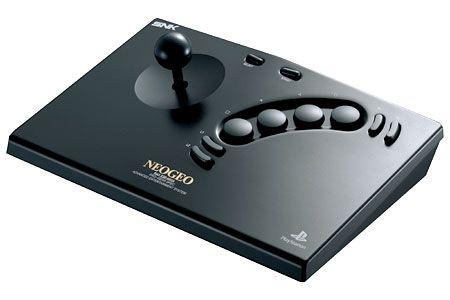Getting poll results. Please wait...
A video game or console can be great, but without the right input device who really cares? Playing a bit off of
Tan's article on the Saitek Cyborg 3D Gold USB,
The RFG Pulse wants your opinion on the
Best Digital Controller. But first a little history might be in order.
Digital controller technology was the primary method utilized until about the mid 1990's. To put it simply, this was basically an On-Off technology: push a button, directional button or joystick and a single response was transmitted to the console to execute an action. The amount of pressure applied was not a factor, as it is in today's analog controllers.
When considering your vote, take into account innovation, control, feel, overall performance and usability. There were many, many more digital controllers released who did not make the list that you see in this poll. The most notable missing is the 'pistol' controller for the
Bally Professional Arcade - a truly sensitive and responsive controller for its time, but not considered a mainstream system by most gamers.
There are some heavy weights in this poll. Who will win?
Vote and add a
comment to state your case!
Atari 2600 - Joystick

Simple, elegant and easy to use. A true classic.
| Mattel Intellivision

Innovative at the time, allowing complex user input. The 'circle' pad allowed quick directional input.
| Nintendo NES

The introduction of the first gamepad. The D-Pad exists to this day in our modern controllers.
|
Sega Genesis

Excellent design and fits like a comfortable pair of shoes.
| Nintendo SNES

Slightly small, dog bone design, but introduced us to the 'shoulder' buttons still utilized today.
| SNK Neo Geo AES

The mother of all controllers. This true arcade stick was / is a classic with excellent control. |
Comments are always welcomed! Let's hear from you!
[img width=300 align=right]http://www.rfgeneration.com/images/hardware/J-112/hw/J-112-H-00010-A_00.jpg[/img]Notable game developer
Bandai was very involved in hardware development and manufacturing beginning in 1977 with its popular line of
TV-Jack pong based consoles (six total releases within two years). Building on their mild success in this arena, the
Bandai Super Vision 8000 debuted in 1979 and was the very first programmable game cartridge system released in Japan. This timeline (1979) and notoriety (initial entry and the developer,
Bandai) may be a surprise to some simply due to the fact that Japan has been a leader in video game technology for some time, with big hitters
Nintendo and
Sega in the fold.
While the video game player in the USA had been exposed to the new programmable game cartridge systems (
Fairchild Channel F,
Atari VCS,
APF MP-1000,
Bally Professional Arcade,
Odyssey 2) beginning in 1976, pong based consoles enjoyed a prolonged following within the Japanese market. This initially retarded the growth, development and embracement of new technology. The release of the
Super Vision 8000 was a small, but significant, step taken by
Bandai in changing the atmosphere within the hardware gaming market in Japan.
Constructed of hard, thick plastics, the light grey chassis of the
Super Vision 8000 is accented well with classic black molding resulting in a clean, crisp look. Cradles for the two included controllers flank the respective sides. This console will never be mistakenly described as being small. The
Super Vision 800 is a healthy sized piece of hardware, relatively rectangular in design with a gradual incline of roughly 15 degrees from the bottom to the top. The seven (7) confirmed games were rendered in 16-bit color across three sound channels, graphically in between the output of the
Atari VCS and the
Mattel Intellivision. Powered by an 8-bit NEC D780C running at 3.58 MHZ that was complimented by a AY-3-8910 coprocessor, this advanced piece of hardware was quite revolutionary, as well as expensive, at that time in Japan. With an initial offering of around 60,000 yen ($560 USD, $1,300 USD comparable in 1979), the
Super Vision 8000 was priced out of the reach of most Japanese gamers.
[img width=300 align=left]http://www.rfgeneration.com/images/hardware/U-013/bf/U-013-H-00010-A.jpg[/img]This console is often mistaken for being a clone of the
Mattel Intellivision, primarily due to controller design. However, the exact opposite actually applies. The
Super Vision 8000 was released prior to the
Intellivision, and the internal hardware specifics are completely different and
not compatible at all. The story behind the controller similarity is varied, with half of those with actual knowledge of both systems siding with the thinking that
Mattel was the original developer, the other stating it was
Bandai. There seems to be more historical data to side with the former in this debate.
Though the hardware technology at the time (1979) in Japan was not as advanced as that in the USA, there is evidence that the
Super Vision 8000 was developed independently, and prior to, the
Intellivision. Further, there are claims that
Bandai was going to sue
Mattel for patent right violation(s) when the initial
Intellivision was displayed at a gaming demonstration forum. There seems to be some validity to this story since
Bandai gained the rights in 1980 to be the sole manufacturer of the
Intellivision console in Japan. With the
Super Vision 8000 not selling well at the time (due to the high price and a changing Japanese market),
Bandai focused their efforts on production of
Intellivision units. This eventually lead to the cessation of production and development for of the
Super Vision 8000 within one year of its release.
[img width=300 align=right]http://www.videogameconsolelibrary.com/images/1970s/79_Bandai_Super_Vision_8000/79_Bandai_games.jpg[/img]
Bandai, though mostly known now as a great game developer, was a big player in the video game hardware industry in Japan and paved the way for juggernauts like
Nintendo and
Sega. The
Super Vision 8000 is an extremely rare system and is considered to be a holy grail amongst console collectors. Games for this system will run you around $80-$100 USD due to their rarity. The system itself was not sold in great quantities. Finding one at all (working or non) is quite a chore. To land yourself a working, CIB unit, expect to lay out $700+, plus S/H. This is definitely a system that should be targeted by only the most serious of console collectors.



